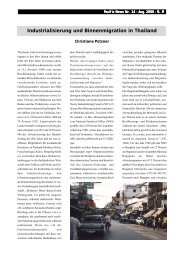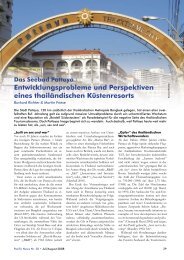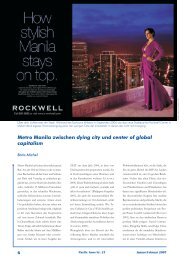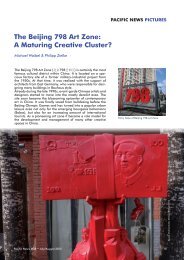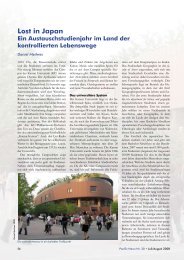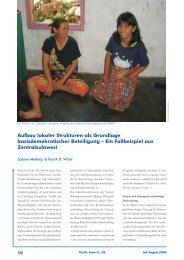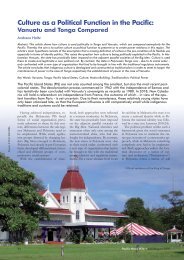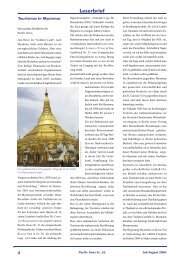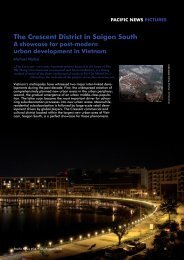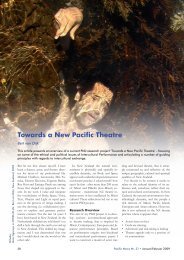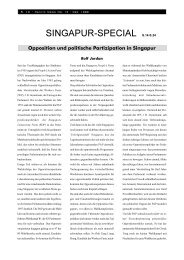Private Appropriation of Public Space: 'Informal' Settlements in Jakarta
Private Appropriation of Public Space: 'Informal' Settlements in Jakarta
Private Appropriation of Public Space: 'Informal' Settlements in Jakarta
You also want an ePaper? Increase the reach of your titles
YUMPU automatically turns print PDFs into web optimized ePapers that Google loves.
PACIFIC NEWS PICTURES<br />
<strong>Private</strong> <strong>Appropriation</strong> <strong>of</strong> <strong>Public</strong> <strong>Space</strong>:<br />
<strong>'Informal'</strong> <strong>Settlements</strong> <strong>in</strong> <strong>Jakarta</strong><br />
Mario Wilhelm<br />
In today's mega-cities space is a scarce resource and its use<br />
is heavily contested. The visible expression <strong>of</strong> these negotiation<br />
processes is evident <strong>in</strong> the constant transformation <strong>of</strong><br />
space. It can be observed that public space has to give way to<br />
high rise <strong>of</strong>fice and apartment towers, government build<strong>in</strong>gs,<br />
monuments, five star hotels, shopp<strong>in</strong>g malls and transport<br />
<strong>in</strong>frastructure. Another <strong>in</strong>terest<strong>in</strong>g phenomenon that can be<br />
observed <strong>in</strong> most mega-cities is what is <strong>of</strong>ten referred to as<br />
slums. The high prices on the property markets push a large<br />
part <strong>of</strong> city dwellers <strong>in</strong>to vulnerable urban pockets. These<br />
settlements are <strong>of</strong>ten described as <strong>in</strong>formal because the communities,<br />
which settle <strong>in</strong> these locations, do not hold legal<br />
land titles. But the label <strong>in</strong>formal is not only used to describe<br />
the liv<strong>in</strong>g space <strong>of</strong> low-<strong>in</strong>come people, it is attached to other<br />
aspects <strong>of</strong> everyday life, as well. For <strong>in</strong>stance, people are<br />
engaged <strong>in</strong> <strong>in</strong>formal sector activities and social life is organized<br />
<strong>in</strong> <strong>in</strong>formal groups.<br />
<strong>Space</strong> is <strong>in</strong>creas<strong>in</strong>gly gett<strong>in</strong>g contested with<strong>in</strong> the<br />
poly-nuclear mega urban region <strong>of</strong> Greater <strong>Jakarta</strong><br />
Source <strong>of</strong> all pictures: Mario Wilhelm; Map Design: Mart<strong>in</strong> Kaiser 2011<br />
Pacific News #37 • January/February 2012<br />
15
PACIFIC NEWS PICTURES<br />
PACIFIC NEWS PICTURES<br />
That way, the label ‘<strong>in</strong>formal’ separates<br />
the everyday life situation <strong>of</strong> low<strong>in</strong>come<br />
households from everyth<strong>in</strong>g<br />
that is formal and thus receives a negative<br />
connotation. As a consequence,<br />
slums are <strong>in</strong> many cases targeted by<br />
a hostile policy environment. Yet, it<br />
is <strong>of</strong>ten neglected that low-<strong>in</strong>come<br />
households fulfill an important function<br />
<strong>in</strong> the urban economy. The competitive<br />
advantage <strong>of</strong> many develop<strong>in</strong>g<br />
countries as well as low cost services<br />
provided to the urban economy is only<br />
made possible because <strong>of</strong> the cheap<br />
reproduction <strong>of</strong> labor. Low-<strong>in</strong>come<br />
employees, maids, <strong>of</strong>fice boys, guards,<br />
drivers, small scale traders, gardeners,<br />
day laborers <strong>in</strong> the construction sector<br />
and so forth are very much needed.<br />
Moreover, <strong>in</strong> the <strong>in</strong>formal sphere<br />
low cost services and goods are <strong>of</strong>fered<br />
to low-<strong>in</strong>come households. This<br />
is an essential aspect <strong>in</strong> <strong>in</strong>sur<strong>in</strong>g their<br />
livelihoods. In order to be able to establish<br />
everyday life <strong>in</strong> a mega-urban<br />
environment, low-<strong>in</strong>come households<br />
have to make use <strong>of</strong> all the resources<br />
that are accessible. One <strong>of</strong> the most<br />
important resources – space – is <strong>of</strong>ten<br />
only available <strong>in</strong> public places. As<br />
a result, it can be observed that public<br />
spaces are used for everyday life.<br />
Therefore, it can be argued that the<br />
private appropriation <strong>of</strong> public space<br />
has two sides. On the one hand, it is<br />
illegal as it conflicts with exist<strong>in</strong>g laws<br />
and regulations; on the other hand, it<br />
is an important strategy for a large<br />
number <strong>of</strong> megacity dwellers to make<br />
a liv<strong>in</strong>g <strong>in</strong> the city for the benefit <strong>of</strong><br />
all. Keep<strong>in</strong>g this contradiction <strong>in</strong> m<strong>in</strong>d,<br />
the pictures provided here have to be<br />
carefully <strong>in</strong>terpreted.<br />
The pictures show different ways <strong>of</strong><br />
private appropriation <strong>of</strong> public space<br />
<strong>in</strong> the Indonesian capital city <strong>Jakarta</strong>.<br />
<strong>Jakarta</strong> has a population <strong>of</strong> around 9.5<br />
million. However, urbanization spilled<br />
over to neighbor<strong>in</strong>g cities with the<br />
effect that Greater <strong>Jakarta</strong> currently<br />
comprises about 24 mill. people. Over<br />
time, the city transformed from a small<br />
harbor town to a mega city. In the past,<br />
a major part <strong>of</strong> the city dwellers lived<br />
<strong>in</strong> a village-type <strong>of</strong> settlement; the<br />
so-called ‘kampung’. With urban development<br />
these kampungs and their<br />
<strong>in</strong>itial mean<strong>in</strong>g altered. The term now<br />
refers to <strong>in</strong>formal settlements. The<br />
most visible once are the dwell<strong>in</strong>gs<br />
Rapid urbanization and modernization<br />
that <strong>in</strong> are Cambodia, developed like along <strong>in</strong> other riverbanks countries<br />
and railway <strong>in</strong> the region, tracks is or <strong>in</strong>creas<strong>in</strong>gly on public land, putt<strong>in</strong>g<br />
e.g. under pressure overhead on urban power land l<strong>in</strong>es. use In for addition<br />
to hous<strong>in</strong>g, purposes public and space <strong>in</strong>vestment. is also<br />
commercial<br />
This used for is most garden<strong>in</strong>g evident activities <strong>in</strong> the and capital, aquaculture.<br />
Penh, Another but commercial is is also the activity case<br />
Phnom<br />
<strong>in</strong> for secondary which public towns space and is appropriated cities where<br />
much is small <strong>of</strong> scale the country’s trade either urban <strong>in</strong> heritage the form is<br />
located. <strong>of</strong> mobile Land vendors prices or <strong>in</strong> small these shops locations that<br />
are very established high and on easily the encourage sidewalk. Less land<br />
owners visible is to the sell use their <strong>of</strong> rivers properties. for wash<strong>in</strong>g, State<br />
land waste with disposal heritage and so huild<strong>in</strong>gs on. <strong>in</strong> prime<br />
locations It is important is given to to po<strong>in</strong>t developers out here <strong>in</strong> that exchange<br />
not only for low-<strong>in</strong>come new public facilities people are at less appropriat<strong>in</strong>g<br />
locations. public Further, space. In small many busi-<br />
ci-<br />
valuable<br />
ness ties, public and shop space owners is or from was constantly core areas<br />
are redeveloped <strong>in</strong>creas<strong>in</strong>gly and <strong>in</strong>vest<strong>in</strong>g transformed <strong>in</strong> their <strong>in</strong>to propertievately<br />
owned for the space, sake <strong>of</strong> such modernity. as <strong>of</strong>fices Ina-<br />
or<br />
pripropriate<br />
apartments. renovation Yet, this thought and modernistic will not<br />
“facelift<strong>in</strong>g“ be further discussed <strong>of</strong> traditional here. What build<strong>in</strong>gs becomes<br />
contribute evident is a lot that to public the destruction space <strong>in</strong>-<br />
thus<br />
<strong>of</strong> creas<strong>in</strong>gly the appearance disappears. and Today, character there <strong>of</strong> heritage<br />
few public areas. places The lack where <strong>of</strong> regulations people can at<br />
are<br />
national meet and level <strong>in</strong>teract, and <strong>of</strong> such a legal as soccer framework fields,<br />
on parks conservation, or playgrounds. and the These fact that spheres heritage<br />
are aga<strong>in</strong> owners privatized and decision so that makers recreational<br />
activities to give little which consideration people liv<strong>in</strong>g to the <strong>in</strong><br />
alike<br />
seem<br />
value most European <strong>of</strong> heritage and build<strong>in</strong>gs, North American mean the<br />
survival cities take <strong>of</strong> for Cambodia’s granted have urban a price heritage<br />
is attached largely to doubtful. it.<br />
Mario Wilhelm (Master <strong>in</strong> International Cultural and Bus<strong>in</strong>ess Studies with a focus on Southeast Asia),<br />
PhD-student at the University <strong>of</strong> Passau, Address: Karpfenstrasse 6, 8942 Oberrieden / Switzerland,<br />
Mobile: +41-79.57.60.039, E-Mail: MarioWilhelm@gmx.net<br />
16 Pacific News #37 • January/February 2012<br />
Pacific News #37 • January/February 2012<br />
17



